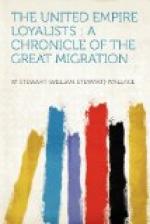Governor Parr’s fears, therefore, had little effect on the popularity of the St John river district. In all, no less than ten thousand people settled on the north side of the Bay of Fundy in 1783. These came, in the main, in three divisions. With the spring fleet arrived about three thousand people; with the summer fleet not quite two thousand; and with the autumn fleet well over three thousand. Of those who came in the spring and summer most were civilian refugees; but of those who arrived in the autumn nearly all were disbanded soldiers. Altogether thirteen distinct corps settled on the St John river. There were the King’s American Dragoons, De Lancey’s First and Second Battalions, the New Jersey Volunteers, the King’s American Regiment, the Maryland Loyalists, the 42nd Regiment, the Prince of Wales American Regiment, the New York Volunteers, the Royal Guides and Pioneers, the Queen’s Rangers, the Pennsylvania Loyalists, and Arnold’s American Legion. All these regiments were reduced, of course, to a fraction of their original strength, owing to the fact that numbers of their men had been discharged in New York, and that many of the officers had gone to England. But nevertheless, with their women and children, their numbers were not far from four thousand.
The arrangements which the government of Nova Scotia had made for the reception of this vast army of people were sadly inadequate. In the first place there was an unpardonable delay in the surveying and allotment of lands. This may be partly explained by the insufficient number of surveyors at the disposal of the governor, and by the tedious and difficult process of escheating lands already granted; but it is impossible not to convict the governor and his staff of want of foresight and expedition in making arrangements and carrying them into effect. When Joseph Aplin arrived at Parrtown, as the settlement at the mouth of the river was for a short time called, he found 1,500 frame houses and 400 log huts erected, but no one had yet received a title to the land on which his house was built. The case of the detachment of the King’s American Dragoons who had settled near the mouth of the river was particularly hard. They had arrived in advance of the other troops, and had settled on the west side of the harbour of St John, in what Edward Winslow described as ‘one of the pleasantest spots I ever beheld.’ They had already made considerable improvements on their lands, when word came that the government had determined to reserve the lands about the mouth of the river for the refugees, and to allot blocks of land farther up the river to the various regiments of provincial troops. When news of this decision reached the officers of the provincial regiments, there was great indignation. ’This is so notorious a forfeiture of the faith of government,’ wrote Colonel De Lancey to Edward Winslow, ’that it appears to me almost incredible, and yet I fear it is not to be doubted. Could we have known




